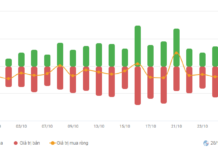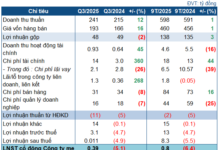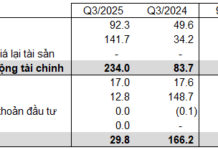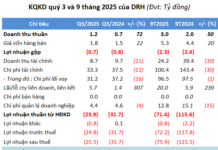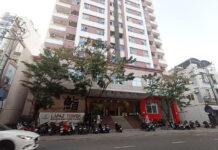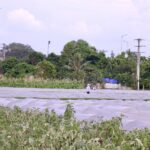The price of a bundle of water spinach in Hanoi has surged to 20,000-30,000 VND, a significant increase from the pre-storm price of 5,000-10,000 VND, as supply remains scarce.
Prices Soar 2-3 Times
A survey on September 18 revealed that green vegetable prices in Hanoi’s markets have soared to twice or thrice their pre-storm levels. Not just water spinach, but basella (Asian spinach) now costs 20,000 VND per 500g bundle, while mustard greens fetch 40,000 VND per kg. Cabbages are priced at 25,000-30,000 VND per kg, and herbs like coriander and scallions command prices of 100,000-200,000 VND per kg.
At Hoang Mai Market in Hoang Mai District, trader Ha Nguyen shared that procuring green vegetables has become challenging due to scarce supply from the north, with shortages at certain times. “The vegetables we receive are not as fresh due to the storms and floods, and they are very expensive. I’ve had to explain to customers that we are selling at higher prices because our suppliers have increased their rates. Honestly, I’m worried about losing customers as they might think we are profiting from the situation,” she said.
While large supermarket chains have committed to stabilizing prices, their vegetable prices remain relatively high, ranging from 20,000 to 40,000 VND per kg.

Green vegetable prices in Hanoi’s markets have soared post-storm. Photo: Thuy Linh
However, some large distribution systems with outlets in Hanoi and northern provinces reported a decrease in demand for goods, including fresh produce, in the North compared to the previous week’s peak. These systems have reduced their enhanced supply to the North by 50% compared to the previous week. “Prices of goods, especially vegetables, remain stable. We are determined to maintain price stability and require suppliers to cooperate in stabilizing prices to support consumers during this challenging period,” said Dinh Quang Khoi, Marketing Director of MM Mega Market.
Another distribution system reported that out of over 240 codes of vegetables and fruits currently sold in the market (including the Northern market), only 29 codes are requested by suppliers in Lam Dong to increase prices. The price increase is entirely objective and convincing, so the system is considering the time of application.
Prioritizing Short-term Vegetable Cultivation
According to Mr. Nguyen Manh Hong, Director of Duc Phat High-tech Agriculture Cooperative in Thanh Tri District, before the storm, the cooperative provided dozens to hundreds of kilograms of vegetables and fruits to distribution systems and intermediaries daily. However, after the storm, the cooperative has no more goods to sell. “The storm damaged and collapsed the houses of the members. Many crops ready for harvest were damaged. The damage is estimated at 3 billion VND,” said Hong.
According to Mr. Hong, Duc Phat Cooperative is hiring workers to rebuild the houses and clean the garden and then grow short-term vegetables such as mustard greens, cauliflower, turnips, and tomatoes for the winter.
According to Mr. Nguyen Nhu Cuong, Director of the Department of Crop Production, Ministry of Agriculture and Rural Development (MARD), Storm No. 3 and the floods have caused 50,612 ha of crops to be flooded and 38,104 ha of fruit trees to be damaged, causing damage of about 1,250 billion VND. In addition, difficult transportation has led to a shortage of some food items and rising prices.
Regarding vegetables, the Director of the Department of Crop Production proposed that localities actively inspect, drain, and clean up the fields, prepare land and seeds for planting in areas that cannot be recovered, giving priority to leafy vegetables, short-term vegetables, and water-loving vegetables to supply the market at the end of the crop.
“According to market demand and specific conditions, for now, we will plant short-term and leafy vegetables. These crops will be ready for harvest in about 25-30 days,” Cuong recommended.
Meanwhile, the Minister of Industry and Trade requested the Departments of Industry and Trade of the northern provinces and cities directly affected by the storm, floods, and inundation to closely monitor the market situation and ensure the supply of essential goods. They also urged, supervised, and requested units trading in essential goods, construction materials, repair supplies, textbooks, medicines, generators, and energy storage devices to commit to stabilizing prices.
The Domestic Market Department regulates the supply of goods between the provinces and cities affected by the floods and other provinces and cities (prioritizing the supply of goods from the Central and Southern regions). The General Department of Market Management strengthens the supervision and timely detection and strict handling of organizations and individuals who take advantage of the impact of Storm No. 3 to hoard goods, push up prices, and violate the law on price stability.
Even vegetable seeds are scarce
According to a report by MARD, to restore vegetable production for the winter-spring 2024-2025, the total demand of the affected localities is 112 tons of vegetable seeds, but the national reserve has only 250 kg left. Therefore, MARD calls on enterprises to join hands to support people in restoring production and ensuring market supply.
Reopening of the Yen Vien – Lao Cai Railway: Delivering Relief Supplies to Flood-Affected Areas
This morning (September 15th), Vietnam Railways successfully cleared the mudslide-affected area and fully restored the Yen Vien-Lao Cai rail line.
The Tourist Island of Cat Ba Regains Power and Telecommunications After Days of ‘Paralysis’
The impact of Storm No. 3 caused several days of disconnection from the mainland. Now, some central areas of Cat Ba town, Cat Hai district, Hai Phong city, have regained their telecommunication networks and power supply. However, the technical infrastructure, power transmission systems, and telecommunication networks in the communes on the island remain damaged and will take a few more days to restore.
The Perfect Storm: How a Typhoon Wreaked Havoc and Blown Away $40,000 Billion Dong, Impacting the Annual GDP
The recent typhoon, Typhoon No. 3, has wreaked havoc in Vietnam, with the Ministry of Planning and Investment reporting a staggering 40 trillion VND in damages. This natural disaster is estimated to decrease this year’s GDP by approximately 0.15%.


